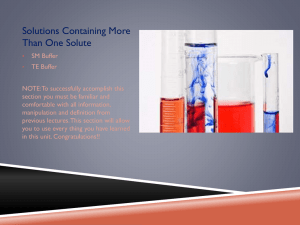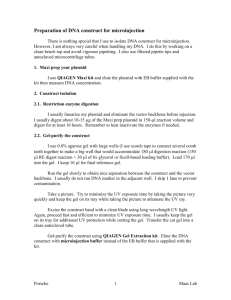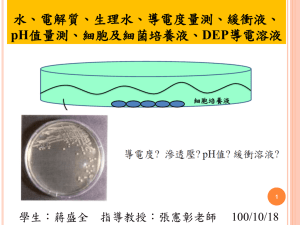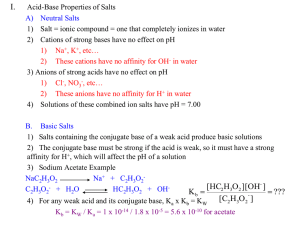Lysis buffer (10 ml)
advertisement
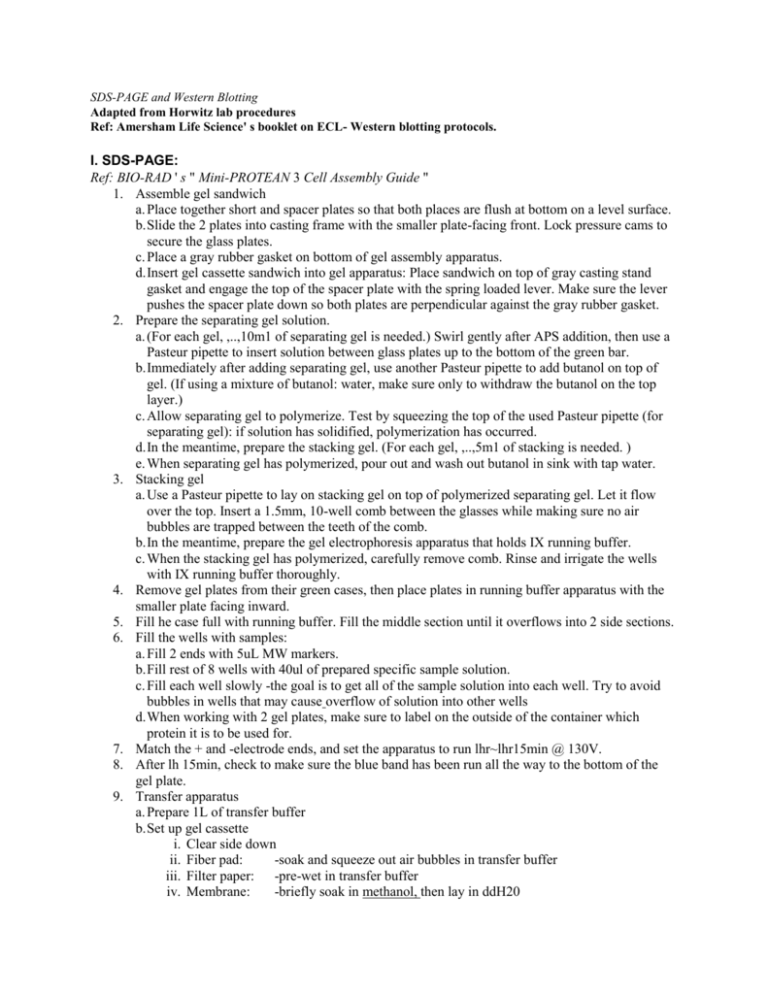
SDS-PAGE and Western Blotting Adapted from Horwitz lab procedures Ref: Amersham Life Science' s booklet on ECL- Western blotting protocols. I. SDS-PAGE: Ref: BIO-RAD ' s " Mini-PROTEAN 3 Cell Assembly Guide " 1. Assemble gel sandwich a. Place together short and spacer plates so that both places are flush at bottom on a level surface. b. Slide the 2 plates into casting frame with the smaller plate-facing front. Lock pressure cams to secure the glass plates. c. Place a gray rubber gasket on bottom of gel assembly apparatus. d. Insert gel cassette sandwich into gel apparatus: Place sandwich on top of gray casting stand gasket and engage the top of the spacer plate with the spring loaded lever. Make sure the lever pushes the spacer plate down so both plates are perpendicular against the gray rubber gasket. 2. Prepare the separating gel solution. a. (For each gel, ,..,10m1 of separating gel is needed.) Swirl gently after APS addition, then use a Pasteur pipette to insert solution between glass plates up to the bottom of the green bar. b. Immediately after adding separating gel, use another Pasteur pipette to add butanol on top of gel. (If using a mixture of butanol: water, make sure only to withdraw the butanol on the top layer.) c. Allow separating gel to polymerize. Test by squeezing the top of the used Pasteur pipette (for separating gel): if solution has solidified, polymerization has occurred. d. In the meantime, prepare the stacking gel. (For each gel, ,..,5m1 of stacking is needed. ) e. When separating gel has polymerized, pour out and wash out butanol in sink with tap water. 3. Stacking gel a. Use a Pasteur pipette to lay on stacking gel on top of polymerized separating gel. Let it flow over the top. Insert a 1.5mm, 10-well comb between the glasses while making sure no air bubbles are trapped between the teeth of the comb. b. In the meantime, prepare the gel electrophoresis apparatus that holds IX running buffer. c. When the stacking gel has polymerized, carefully remove comb. Rinse and irrigate the wells with IX running buffer thoroughly. 4. Remove gel plates from their green cases, then place plates in running buffer apparatus with the smaller plate facing inward. 5. Fill he case full with running buffer. Fill the middle section until it overflows into 2 side sections. 6. Fill the wells with samples: a. Fill 2 ends with 5uL MW markers. b. Fill rest of 8 wells with 40ul of prepared specific sample solution. c. Fill each well slowly -the goal is to get all of the sample solution into each well. Try to avoid bubbles in wells that may cause overflow of solution into other wells d. When working with 2 gel plates, make sure to label on the outside of the container which protein it is to be used for. 7. Match the + and -electrode ends, and set the apparatus to run lhr~lhr15min @ 130V. 8. After lh 15min, check to make sure the blue band has been run all the way to the bottom of the gel plate. 9. Transfer apparatus a. Prepare 1L of transfer buffer b. Set up gel cassette i. Clear side down ii. Fiber pad: -soak and squeeze out air bubbles in transfer buffer iii. Filter paper: -pre-wet in transfer buffer iv. Membrane: -briefly soak in methanol, then lay in ddH20 v. Gel- to be placed in the next step vi. Remove gel case from apparatus. Crack plates open with a wet razor and gently slide stacking gel off vii. Place gel on-top of membrane paper using a wet razor viii. Filter paper: - (pre-wet in transfer buffer) ix. Then fiber pad (air bubbles soaked and squeezed out in transfer buffer). c. Close together cassette and insert into transfer buffer apparatus -black side facing black side. 10. Set up running buffer to run for 1 hour @ 100V. 11. Put in the ice block. II. Western Blotting 1. Remove membrane paper from IX transfer buffer apparatus. (Remember which side the gel proteins transferred onto, and sign your name that side's bottom right hand corner.) 2. Make Blotto (25mL for one blot in a 50mL test tube.) Place tube on vortex at highest speed for a few seconds. a. 5% w/v: -ex. 0.5g/10mL or 1.25g/25mL 3. Place membrane in Blotto for 1 hr @ RT w/constant agitation. 4. Wash blot 3X5min in TBS-T. 5. Place membrane in primary solution (10mL for 1 blot) @ RT for 1 hr. or overnight @ 4 C w/constant agitation. 6. Pour primary solution back into its original test tube for reuse. 7. Wash blot 3X5min in TBS-T. 8. In the meantime, prepare secondary antibody solution- 1:10000 dilution of monoclona1/polyclonal antibody in Blotto (10mL for one blot). 9. Place membrane in secondary solution @ RT for 1 hr. or overnight @ 4 C w/constant agitation. 10. Wash blot 3X5min in TBS-T. 11. Prepare detection reagent: 1mL reagent A + 1mL reagent B 12. Place blot on Saran wrap. Pipette above reagent onto blot, covering the entire blot surface. 13. Let sit for 1min. a. When developing 2 blots at the same time, keep the 2nd one wrapped in TBS-T. 14. Remove excess liquid with filter paper. 15. Develop blot. 16. If needed, store the blot wrapped in Saran wrap with TBS-T at 4C. III. Stripping & Reprobing 1. Stripping a. ~25mL guanidine HCL for 10min @ RT w/constant agitation. b. Wash blot 1X5min in TBS-T. 2. Block with Blotto…(GO TO step 2 from above) SDS-PAGE and Western blotting buffers 2X sample buffer (5 ml) Store @ -70 C in 1 ml aliquots 0.625 ml 1 M Tris, pH 6.8 (125 mM) 1 ml 20% SDS (4%, or 0.2 g) 1 ml glycerol (20%) 0.1 ml 1% bromphenol blue in 10% EtOH (0.02%) (Add 200 mM DTT = 0.1542 g or 10% BME if needed for reducing conditions) Fill to 5 ml with H2O (~2.275 ml) 4X sample buffer (5 ml) Store @ -70 C in 1 ml aliquots 0.5 ml 2.5 M Tris, pH 6.8 (250 mM) 2 ml 20% SDS (8%) 2 ml glycerol (40%) 0.2 ml 1% bromphenol blue in 10% EtOH (0.04%) (Add 400 mM DTT = 0.3084 g if desired; it’s not recommended to add 20% BME to the 4X buffer) Fill to 5 ml with H2O (~ 0.3 ml) 10X running buffer Store @ RT 29 g Tris base (240 mM) 144 g glycine (1.9 M) 10 g SDS Volume to 1 L (don’t pH) Transfer buffer Make fresh or Store @ RT w/o MeOH 2.9 g Tris base (12 mM) 14.4 g glycine (100 mM) 200 ml MeOH 1 ml 20% SDS Volume to 2 L (don’t pH) Separating gels (30 ml) X ml Protogel (X = desired % final) 7.8 ml Protogel buffer 30 ul TEMED Volume to 30 ml with H2O Degas if desired, then add: 300 ul freshly-made 10% APS in H2O Stacking gels (10 ml) 1.3 ml Protogel (4 % final) 2.5 ml Protogel stacking buffer 6.1 ml H2O 10 ul TEMED 5 ul 2000x phenol red concentrate (Sigma) Degas if desired, then add: 50 ul 10% APS Protogel (National Diagnostics) contains 30% w/v acrylamide, 0.8% w/v bis-acrylamide Protogel buffer contains 1.5 M Tris-HCl, 0.384% SDS, pH 8.8 Protogel stacking buffer contains 0.125 M Tris-HCl, 0.1% SDS, pH 6.8 Coomassie blue staining solution 0.1% w/v Coomassie blue R250 40% MeOH 10% HAc Destaining solution 30% MeOH 10% HAc Longer destaining solution 5% MeOH 7.5% HAc 5% glycerol TBS-Tween Stable for weeks @ RT (Tween can oxidize) 40 ml 1 M Tris-HCl, pH 7.5 (20 mM) 54.8 ml 5 M NaCl (137 mM) Volume to 2 L with H2O, then add: 2 ml Tween (0.1%, Fisher Scientific—for TBS just omit this) (can add 0.02% NaN3 to prevent bacterial growth) Stripping buffer 3 ml 20% SDS (2%) 0.75 ml 2.5 M Tris, pH 6.8 (62.5 mM) 0.21 ml BME—d=1.114, 14.3 M stock liquid (100 mM) 26.04 ml H2O 10X PBS 80 g NaCl 2 g KCl 14.4 g Na2HPO4 2.4 g NaH2PO4 Add 900 ml H2O pH to ~7.0 with NaOH pellets Volume to 1 L and filter 10X TAE 24.2 g Tris base 5.71 ml HAc 10 ml 0.5 M EDTA, pH 8.0 Volume to 500 ml with H2O 1X BSA blocking and Ab dilution buffer 1% BSA in TBS-T or TBS + 0.01-0.1% Triton Lysis buffer (10 ml) Final concentrations in the lysis buffer are in parentheses. Solutions stored at 4C 5.665 ml ddH2O 1 ml 0.5 M -glycerophosphate, pH 7.3 (50 mM) 1 ml 0.1 M NaPP (10 mM) 0.600 ml 0.50 M NaF (30 mM) 0.500 ml 1 M Tris, pH 7.5 (50 mM) 0.500 ml 20% Triton X-100 (1%) 0.300 ml 5 M NaCl (150 mM) 0.100 ml 100 mM benzamidine (1 mM) 0.040 ml 500 mM EGTA (2 mM) >>0.5 M: 1.485 g of hydrate in 10 ml H2O >>0.1 M NaPP: 0.8922 g in 20 ml H2O >>0.5 M NaF: 0.4199 g in 20 ml H2O >>1 M Tris: 12.11 g Tris base in 100 ml H2O >>20 g Triton X-100 (d = 1.07) in 100 ml H2O >>5 M NaCl: 2.92 g NaCl in 10 ml H2O >>100 mM: 0.313 g in 20 ml H2O >>500 mM EGTA: 3.804 g in 20 ml H2O—increase pH Solutions stored at -20C 0.025 ml 40 mM sodium orthovanadate (100 M) 0.020 ml 500 mM DTT (1 mM) >>40 mM: 0.07356 g in 10 ml H2O >>500 mM DTT: 0.771g in 10 ml H2O Sensitive Items -20C 0.020 ml 5 mg/ml aprotinin (10 g/ml) 0.020 ml 5 mg/ml leupeptin (10 g/ml) 0.010 ml 1 mg/ml pepstatin (1 g/ml) 0.010 ml 1 mg/ml Microcystin (1 g/ml) 4C 0.200 ml 50 mM PMSF (1 mM) Blocking Buffer 1% BSA in: 0.500 ml 1 M Tris, pH 7.5 (50 mM) 0.300 ml 5 M NaCl (150 mM) 0.025 ml 20% Triton X-100 (0.05%) 9.175 ml ddH2O Wash Buffer 0.500 ml 1 M Tris, pH 7.5 (50 mM) 0.300 ml 5 M NaCl (150 mM) 9.200 ml ddH2O H3PO4 87 l 85% H3PO4 (stock) in 10 ml ddH2O. >>2 mg in 2 ml MeOH made in EtOH >>made in EtOH Kinase Assay Buffer Component Stock Conc. Working Conc. Units Volume (l) to add to make 1000 l Stored at 4C Tris, pH 7.5 MgCl2 -gly EGTA Stored at -20C Na3VO4 DTT PKA inhibitor PKC inhibitor Calmidazolium ATP* 1000 1000 500 500 20 15 5 1 mM mM mM mM 30 22.5 15 3 40 500 450 450 10000 1000 0.2 0.2 0.4 4 4 25 mM mM M M M M 7.5 0.6 2.67 26.67 1.2 75 P32-ATP** 0.555 0.0056 M 30 ddH2O Notes volume = 78.6 l Dissolved in DMSO Dilute only when ready to use Cold:Hot ATP ratio = 4504.50 Specific Activity of Hot = 3000 Ci/mmol Specific Activity of Total ATP = 0.67 Ci/mmol = 1.48E6 dpm/nmol 785.87 * First dilute the 10 mM stock by 10-fold in water, then use 75 l of the diluted stock. ** Dilute the stock (3.33 M, 10 Ci/l) 32P-ATP by 6-fold in 10 mM (pH = 7.6) Tricine and store in aliquots. Do not freeze/thaw aliquots more than 3-4 times. Kinase Wash Buffer Component Stock Conc. Working Conc. Units Tris, pH 7.5 MgCl2 -gly EGTA Na3VO4 DTT 1000 1000 500 500 40 500 20 15 5 1 0.2 0.2 mM mM mM mM mM mM Volume (ml) to add to make 10 ml 0.3 0.225 0.15 0.03 0.075 0.006 ddH2O Reaction mix: 9.214 20 l KWB 20 l KAB 20 l MBP (stock concentration = 2 mg/ml) Total radioactivity per well = 1 Ci (from 50 Ci in 1000 l of KAB) Notes volume = 0.786 ml— take 78.6 l out for KAB; then add only 8.2926 ml ddH2O




